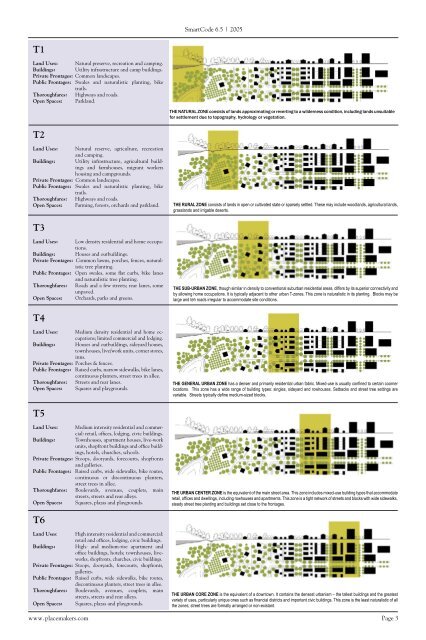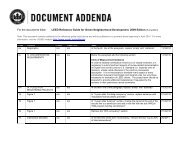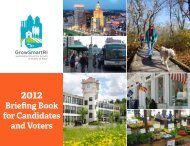SmartCode Summary Report
SmartCode Summary Report
SmartCode Summary Report
You also want an ePaper? Increase the reach of your titles
YUMPU automatically turns print PDFs into web optimized ePapers that Google loves.
<strong>SmartCode</strong> 6.5 | 2005<br />
T1<br />
Land Uses: Natural preserve, recreation and camping.<br />
Buildings: Utility infrastructure and camp buildings.<br />
Private Frontages: Common landscapes.<br />
Public Frontages: Swales and naturalistic planting, bike<br />
trails.<br />
Thoroughfares: Highways and roads.<br />
Open Spaces: Parkland.<br />
THE NATURAL ZONE consists of lands approximating or reverting to a wilderness condition, including lands unsuitable<br />
for settlement due to topography, hydrology or vegetation.<br />
T2<br />
Land Uses: Natural reserve, agriculture, recreation<br />
and camping.<br />
Buildings: Utility infrastructure, agricultural buildings<br />
and farmhouses, migrant workers<br />
housing and campgrounds.<br />
Private Frontages: Common landscapes.<br />
Public Frontages: Swales and naturalistic planting, bike<br />
trails.<br />
Thoroughfares: Highways and roads.<br />
Open Spaces: Farming, forests, orchards and parkland.<br />
THE RURAL ZONE consists of lands in open or cultivated state or sparsely settled. These may include woodlands, agricultural lands,<br />
grasslands and irrigable deserts.<br />
T3<br />
Land Uses: Low density residential and home occupations.<br />
Buildings: Houses and outbuildings.<br />
Private Frontages: Common lawns, porches, fences, naturalistic<br />
tree planting.<br />
Public Frontages: Open swales, some flat curbs, bike lanes<br />
and naturalistic tree planting.<br />
Thoroughfares: Roads and a few streets; rear lanes, some<br />
unpaved.<br />
Open Spaces: Orchards, parks and greens.<br />
THE SUB-URBAN ZONE, though similar in density to conventional suburban residential areas, differs by its superior connectivity and<br />
by allowing home occupations. It is typically adjacent to other urban T-zones. This zone is naturalistic in its planting. Blocks may be<br />
large and teh roads irregular to accommodate site conditions.<br />
T4<br />
Land Uses: Medium density residential and home occupations;<br />
limited commercial and lodging.<br />
Buildings: Houses and outbuildings, sideyard houses,<br />
townhouses, live/work units, corner stores,<br />
inns.<br />
Private Frontages: Porches & fences.<br />
Public Frontages: Raised curbs, narrow sidewalks, bike lanes,<br />
continuous planters, street trees in allee.<br />
Thoroughfares: Streets and rear lanes.<br />
Open Spaces: Squares and playgrounds.<br />
THE GENERAL URBAN ZONE has a denser and primarily residential urban fabric. Mixed-use is usually confined to certain coorner<br />
locations. This zone has a wide range of building types: singles, sideyard and rowhouses. Setbacks and street tree settings are<br />
variable. Streets typically define medium-sized blocks.<br />
T5<br />
Land Uses: Medium intensity residential and commercial:<br />
retail, offices, lodging, civic buildings.<br />
Buildings: Townhouses, apartment houses, live-work<br />
units, shopfront buildings and office buildings,<br />
hotels, churches, schools.<br />
Private Frontages: Stoops, dooryards, forecourts, shopfronts<br />
and galleries.<br />
Public Frontages: Raised curbs, wide sidewalks, bike routes,<br />
continuous or discontinuous planters,<br />
street trees in allee.<br />
Thoroughfares: Boulevards, avenues, couplets, main<br />
streets, streets and rear alleys.<br />
Open Spaces: Squares, plazas and playgrounds.<br />
THE URBAN CENTER ZONE is the equivalent of the main street area. This zone includes mixed-use building types that accommodate<br />
retail, offices and dwellings, including rowhouses and apartments. This zone is a tight network of streets and blocks with wide sidewalks,<br />
steady street tree planting and buildings set close to the frontages.<br />
T6<br />
Land Uses: High intensity residential and commercial:<br />
retail and offices, lodging, civic buildings.<br />
Buildings: High- and medium-rise apartment and<br />
office buildings, hotels; townhouses, liveworks,<br />
shopfronts, churches, civic buildings.<br />
Private Frontages: Stoops, dooryards, forecourts, shopfronts,<br />
galleries.<br />
Public Frontages: Raised curbs, wide sidewalks, bike routes,<br />
discontinuous planters, street trees in allee.<br />
Thoroughfares: Boulevards, avenues, couplets, main<br />
streets, streets and rear alleys.<br />
Open Spaces: Squares, plazas and playgrounds.<br />
THE URBAN CORE ZONE is the equivalent of a downtown. It contains the densest urbanism – the tallest buildings and the greatest<br />
variety of uses, particularly unique ones such as financial districts and important civic buildings. This zone is the least naturalistic of all<br />
the zones; street trees are formally arranged or non-existant.<br />
www.placemakers.com Page 3







